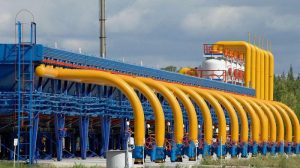
Transit of gas through Ukraine should remain even after the construction of Nord Stream 2, German Foreign Minister Heiko Maas said.
Maas told journalists in Berlin on Wednesday that Chancellor Angela Merkel told Russian President Vladimir Putin long ago that for Germany, the completion of the construction of Nord Stream 2 is associated with the need for further gas transit through Ukraine.
According to him, nothing will change in Germany’s position in this regard.

Transit of natural gas through the gas transmission system (GTS) of Ukraine in January-April 2021 amounted to 14.1 billion cubic meters, which is 9% less than in the same period in 2020 (15.5 billion cubic meters), according to the statement of Gas Transmission System Operator of Ukraine LLC (GTSOU).
In particular, 12.5 billion cubic meters of gas were supplied in the western direction as transit (8.4 billion cubic meters to Slovakia, 2.9 billion cubic meters to Hungary, 1.2 billion cubic meters to Poland), 1.7 billion cubic meters to the south (1.3 billion cubic meters to Moldova, and 0.4 billion cubic meters to Romania).
According to Commercial Director of the operator Yevhen Todorov, GTSOU put up for auction for the distribution of additional capacities at interstate entry points from the Russian Federation for May 2021. However, market participants, in particular the Russian side, did not show interest in the proposal.
“Taking into account the seasonal market demand for gas in the EU and limited transportation volumes, starting from April 1, 2021, the price at gas hubs has shown an increase and from the beginning of the year to May 12, it has increased by 36%, to EUR 26.4 per MWh at the NCG hub on condition of delivery one day ahead (about EUR 279 per 1,000 cubic meters),” he said.
In addition, gas transportation from Europe to Ukraine in January-April 2021 amounted to 0.55 billion cubic meters, which is seven times less than in the same period in 2020 (3.87 billion cubic meters). Ukraine received 0.07 billion cubic meters of gas from NCG, 0.48 billion cubic meters from Hungary, while almost no gas was delivered to the country from Poland, Romania and Moldova.
Gas supplies as virtual reverse flow to Ukraine amounted to 0.49 billion cubic meters, or almost 90% of transportation. Gas flow in the “customs warehouse” mode amounted to 0.08 billion cubic meters versus 1.22 billion cubic meters in the same period in 2020.
Gas re-export from Ukraine in the four months ended April 2021 amounted to 0.68 billion cubic meters, while for the whole last year traders almost did not order re-export services.

Gazprom is thus far keeping to a stable approach to the use of Ukrainian transit capacities.
“You see our bookings. Our bookings are visible. Thus far, we remain at the same level,” Gazprom deputy head Elena Burmistrova said during Investor Day when asked about the prospects of increasing transit.
“We’ve had a very difficult winter in Europe, in Russia, in Asia. So we are now looking at our balances and resources – and looking at how we are going to move forward following the end of Q1,” she said.
In April, Gazprom pumps an average of 124 million cubic meters per day through Ukraine, fully using booked volume.
Europe is experiencing a notable shortage of gas for pumping into underground gas storage facilities.
Last Friday, the Ukrainian GTS Operator unexpectedly announced an auction for additional gas pumping to Europe in May in volume of half of current supplies: 64 million cubic meters per day above the current pumping capacity of 124 million cubic meters. However, capacity was left unused following the auction.

Naftogaz Group reduced capital expenditures (capex) by 44.5% (or by UAH 12.193 billion) in 2020 compared to 2019, to UAH 15.044 billion.
As indicated in the consolidated statements of the group published on Tuesday, capex of the exploration and production segment was UAH 11.023 billion (a fall of 26.2% to 2019), oil midstream and downstream – UAH 1.185 billion (a fall of 35.4%), Ukrnafta – UAH 1.113 billion (a fall of 23%), gas storage – UAH 0.143 billion (a rise of 3.3 times), commerce – UAH 0.133 billion (a rise of 11.1 times), other – UAH 1.448 billion (a fall of 83.8%).
As reported, the consolidated net loss of NJSC Naftogaz Ukrainy in 2020 amounted to UAH 19.002 billion compared to a net profit of UAH 63.294 billion in 2019. Excluding the results of the discontinued operations, including the Gas Transit Arbitration award of UAH 55.7 billion, the net profit was UAH 2.6 billion.
Naftogaz’s revenues in 2020 grew by 27.1% (by UAH 41.184 billion) compared to 2019, to UAH 193.017 billion, including income from sales being UAH 159.234 billion (a rise of 6.3%), compensation for performing public service obligations totaling UAH 32.205 billion (a rise of 100%), and interest and other income reaching UAH 1.578 billion (a fall of 23.1%).
The net loss of NJSC Naftogaz Ukrainy, as a separate legal entity, in 2020 amounted to UAH 18.002 billion versus UAH 50.658 billion of net profit for 2019. Net income last year decreased 32.1% compared to 2019, to UAH 121.059 billion.

Gazprom is booking extra capacities for gas transit through Ukraine for March at the same additional reservation volume as for February, according to the results of the monthly Regional Booking Platform (RBP) auction.
Gazprom has a long-term reservation of Ukrainian capacities in the volume of 40 billion cubic meters for 2021, which is equal to 110 million cubic meters per day.
The Russian gas company booked extra transit capacities for March via RBP on Monday. It requested 14.2 mcm per day of the offered 15 mcm per day. The auction result was the same for February.
From February 1 to 13, Gazprom pumped an average of 119.1 mcm per day through Ukraine, with a minimum amount of 115.4 mcm and a maximum of 121 mcm.
In January 2021, the company transported 124.51 mcm per day on average through Ukraine, and in December – 182.63 mcm per day.

Transit of natural gas through the gas transmission system (GTS) of Ukraine in 2020 amounted to 55.8 billion cubic meters, which is 37.7% less than in 2019 (89.6 billion cubic meters).
According to the report of Gas Transmission System Operator of Ukraine (GTSOU), 51.9 billion cubic meters of gas have been supplied in the western direction (Slovakia – 38.5 billion cubic meters, Hungary – 9.6 billion cubic meters, Poland – 3.8 billion cubic meters), which is 32% less than in 2019, in the south direction – 3.9 billion cubic meters (Moldova – 3 billion cubic meters, Romania – 900 million cubic meters), which is 70% less than last year in this direction.
“The key factors in reducing transit volumes to Europe are the launch of new gas pipelines bypassing Ukraine [the Turkish Stream], as well as a decrease in gas demand in the EU and significant gas reserves in European UGS facilities,” the statement says.
The company said that the agreement with Gazprom provides for booking 65 billion cubic meters in 2020. Thus, last year’s transit was 14% less (by 9.2 billion cubic meters) than provided for in the contract. At the same time, Gazprom paid in full for the booked 65 billion cubic meters of transit capacity.
The average daily transit volume for the year was 153 million cubic meters with the booked 178 million cubic meters. At the same time, in December, due to additional transit capacities ordered by Gazprom, it amounted to 183 million cubic meters.
In addition, gas transportation from Europe to Ukraine in 2020 amounted to 15.9 billion cubic meters, which is 12% more than in 2019 (14.2 billion cubic meters). In particular, Slovakia last year delivered 10.2 billion cubic meters of gas (up by 11% from 2019), Hungary – 4.2 billion cubic meters (14% more), Poland – 1.5 billion cubic meters (3% more).